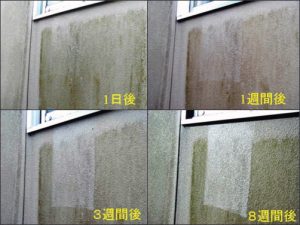It can be applied to most substances. However, when applying directly to a target exposed to direct sunlight on an organic surface such as plastic or painted surfaces, if the photocatalyst is applied directly, the surface of the base substance will not be stable due to the photocatalyst function and the film will peel off. In such cases, be sure to apply an inorganic protective layer (undercoat) to the surface of the base substance, and then apply a photocatalyst (topcoat) on top of it. Also, when applying to a highly water-repellent base substance, it may be necessary to do pretreatment or use additives solution in combination.
The cause of sick house syndrome is volatile organic compound gas (VOC gas).
The photocatalyst decomposed/detoxifying harmful gases as well as deodorizing effects.
In the case of a new house, there is no problem basically because building materials are adopted after strict inspection, but there are many cases where a sick house develops after entering, and the cause is said that imported furniture or sofas etc. However, VOC gas that has volatilized once adsorbs in the room, and then it gradually diffuses and affect the human body. If you coat the whole room with a visible light reaction type photocatalyst before moving in, it is safe because the emitted VOC gas continues to be decomposed. However, it does not work in a state where the light does not enter and shutting the door, window completely. Immediately after entering a new house, ventilate well, open the curtains and receive light as much as possible to maximize the photocatalyst activity.

Depending on the client's requirements, we generally cover appliances, precision instruments, and artwork. The reason is to avoid the risk of any malfunction.
Even if you cannot apply it evenly and try to start over, once it dries, it is nano-sized titanium oxide, so you can only remove it by scraping the entire base. Oxidative decomposition occurs when the surface of the film is exposed to light, so if there is a coating missing spot, the dirt will become more noticeable over time.
In addition, the surface area of titanium oxide must be formed as large as possible on the coated surface so that oxidative decomposition can occur efficiently and appropriately. For that reason, it is necessary to have the photocatalyst knowledge and film formation theory.
● Bases that require an undercoat: Painted surfaces, concrete with clear paint treatment, marble, water repellent treatment, etc.
● Bases that not require an undercoat: unfinished concrete, tiles, bricks, stones, charcoal, glass *, lysine, jolipads, spray tiles, etc.
* Glass has an organic substance (oil film) on the surface during the manufacturing process, so it must be removed by polishing before application.
These are just guidelines. Since the quality varies depending on the surrounding environment and the paint / material manufacturer, we recommend that you perform test coating in advance with a sample or on-site. We will decide the solution selection and usage amount after discussing with the client such as the foundation of the property to be constructed and the surrounding environment.
